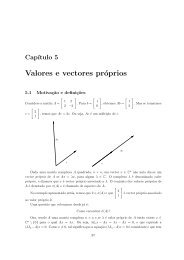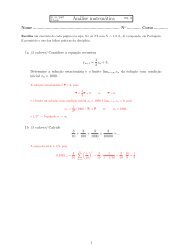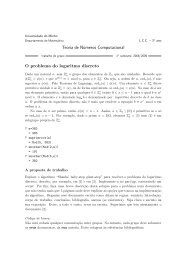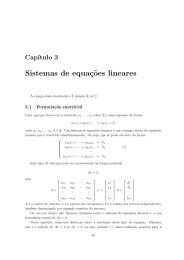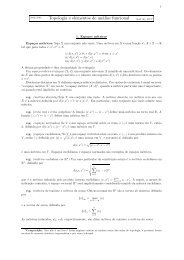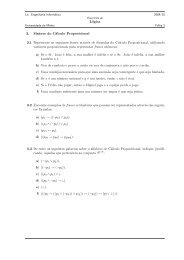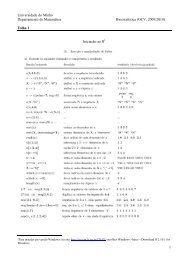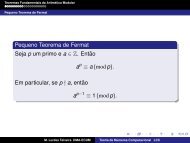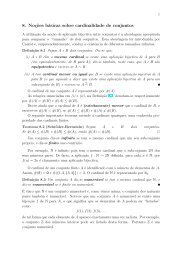My title - Departamento de Matemática da Universidade do Minho
My title - Departamento de Matemática da Universidade do Minho
My title - Departamento de Matemática da Universidade do Minho
Create successful ePaper yourself
Turn your PDF publications into a flip-book with our unique Google optimized e-Paper software.
6 FLOWS 48<br />
Example (simple ODEs). Consi<strong>de</strong>r the simple ODE ẋ = v(t) with initial condition x(t 0 ) = x 0 .<br />
Picard’s recipe, starting from the initial guess φ(t) = x 0 gives, already at the first step,<br />
which is the solution we know.<br />
∫ t<br />
(Pφ) (t) = x 0 + v(s)ds<br />
t 0<br />
Example (the exponential). Suppose you want to solve ẋ = x with initial condition x(0) = 1.<br />
You start with the guess φ(t) = 1, and then compute<br />
(Pφ) (t) = 1 + t<br />
(<br />
P 2 φ ) (t) = 1 + t + 1 2 t2 ... (P n φ) (t) = 1 + t + 1 2 t2 + ... + 1 n! tn<br />
Hence the sequence converges (uniformly on boun<strong>de</strong>d intervals) to the Taylor series of the exponential<br />
function<br />
(P n φ) (t) → 1 + t + 1 2 t2 + ... + 1 n! tn + ... = e t ,<br />
which is the solution we already knew.<br />
Details of the proof of the Picard’s theorem. Choose a sufficiently small rectangular<br />
neighborhood<br />
I × B = [t 0 − ε, t 0 + ε] × B δ (x 0 )<br />
around (t 0 , x 0 ), where B = B δ (x 0 ) <strong>de</strong>notes the closed ball with center x 0 and radius δ in X. There<br />
follows from continuity of v that there exists K such that<br />
|v(t, x)| ≤ K<br />
for any (t, x) ∈ I × B. There follows from the local Lipschitz condition for v that there exists M<br />
such that<br />
|v(t, x) − v(t, y)| ≤ M|x − y|<br />
for any t ∈ I and any x, y ∈ B. Now restrict, if nee<strong>de</strong>d, the (radius of the) interval I in such a<br />
way to get both the inequalities Kε ≤ δ and Mε < 1. Let C be the space of continuous functions<br />
t ↦→ φ(t) sending I into B. Equipped with the sup norm<br />
‖φ − ϕ‖ = sup |φ(t) − ϕ(t)|<br />
t∈I<br />
this is a complete space. One verifies that the Picard’s map sends C into C, since<br />
| (Pφ) (t) − x 0 | ≤<br />
∫ t<br />
Finally, given two functions φ, ϕ ∈ C, one sees that<br />
| (Pφ) (t) − (Pϕ) (t)| ≤<br />
∫ t<br />
t 0<br />
|v (s, φ(s)) |ds ≤ Kε ≤ δ.<br />
t 0<br />
|v (s, φ(s)) − v (s, ϕ(s)) |ds ≤ Mε sup<br />
t∈I<br />
|φ(t) − ϕ(t)|<br />
hence ‖Pφ − Pϕ‖ < Mε‖φ − ϕ‖. Since Mε < 1, this proves that the Picard’s map is a contraction<br />
and the fixed point theorem allows to conclu<strong>de</strong>.<br />
We may not be able to solve them! Last but not least, we must keep in mind that we are<br />
not able to solve all equations. Actually, although we may prove the existence and the uniqueness<br />
for large classes of equations, we are simply not able to explicitly integrate the really interesting<br />
differential equations...<br />
Ultimately we must recur to numerical methods to find approximate solutions and to qualitative<br />
analysis





